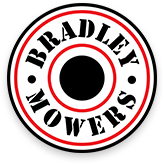Keeping a healthy looking lawn makes your home look enticing and gives you a sense of pride when seeing it. If you are new to home ownership there can be a lot of questions that come to mind when first attempting to mow your lawn. What should the blade height be set at? What is the best pattern to mow? Are grass clippings harmful to your lawn? Below we're going to take a look at the best answers to these questions.
Adjusting Blade Height
Each mower, whether you ride it or push it, will have multiple height settings to ensure you get the best looking cut for your law. Picking the right height allows for a healthy lawn that is more resistant to disease, insects, and droughts. It also provides a healthy root system that greatly reduces weed problems.
As a general rule of thumb you should cut off one-third of your lawn's present height. This will ensure that your grass is long enough to resist potential hazards and will save you from having to bag grass clippings. Try adjusting your lawnmower to around what seems like one-third of the current grass blades and mow a small section of your lawn. Keep adjusting as necessary until you get the one-third height you are looking for, then proceed to mow your entire lawn.
Proper Mowing Patterns
While there are some extravagant law mowing patterns, like zig-zags and multiple spirals, many people aren't going to take that much care in mowing their lawn. For typical homes the choice comes down to two options, mowing in rows or mowing in a big spiral.
The most general rule to follow when deciding how to mow your lawn is to not move over the same patch of grass more than once. You want efficiency when mowing your lawn. If you tend to use a riding mower it can more difficult to make precise turns, and can leave uncut patches. Use your common sense and come up with a method that works best for the equipment you have. You can always cut it differently next week.
Leave Or Remove The Clippings
This is such a common question in the lawn mowing industry, and many people have differing opinions. The choice is really up to you. If you follow the one-third rule of cutting your lawn above, you won't need to worry about grass clippings. In fact, it's more beneficial to leave them on the lawn as they will return valuable nutrients to the soil.
Grass clippings do act like a fertilizer. They both contain phosphorus, nitrogen, and potassium, so essentially you're saving money by using the free grass clippings as compared to buying fertilizer. It is a lot less work to leave the clippings lay.
There are a couple of cases where picking up the clippings is a more ideal solution. If your lawn has a disease or fungus spreading it's a good idea to collect the clippings. There are bags that fit on a push-behind lawnmower. Riding motors tend to have sweeper attachments that will pick up clippings into one big collection bin.
Some people do prefer to collect their clippings to use them on a compost pile or as mulch. This works fine, however, be sure to not use clippings after you recently applied weed killer to your lawn. This could create a problem with your compost and areas where you spread the mulch.
By following these simple best practices your lawn will be healthy and green all year round.
